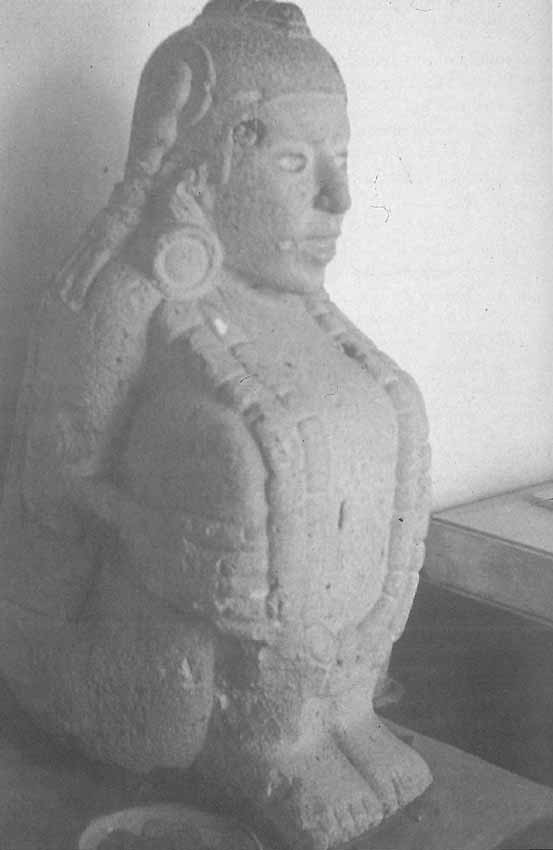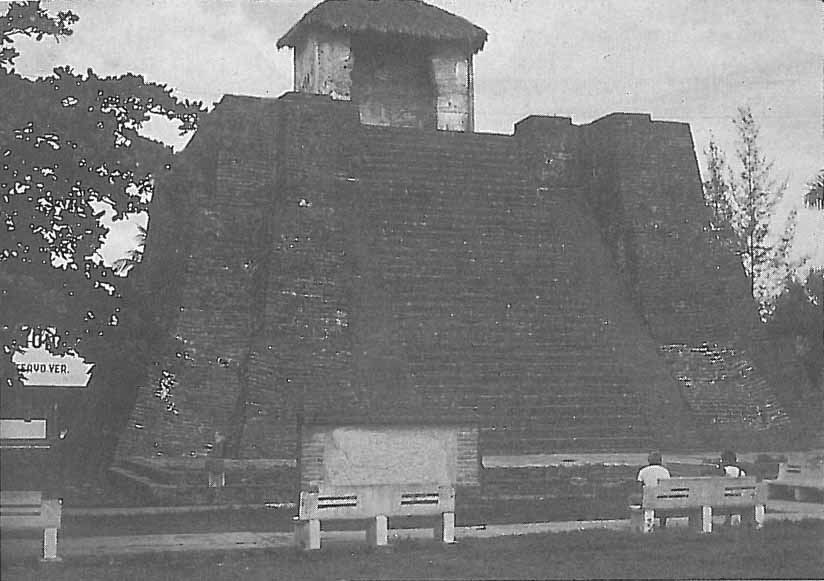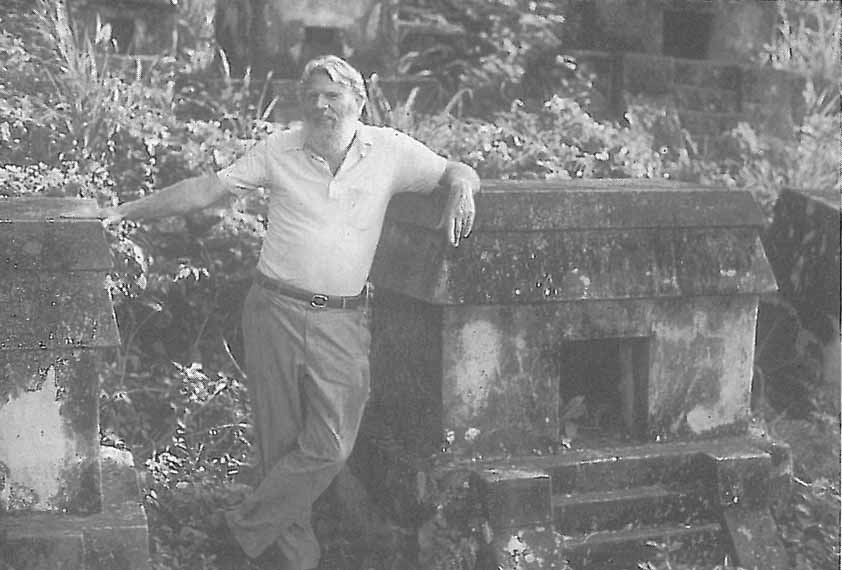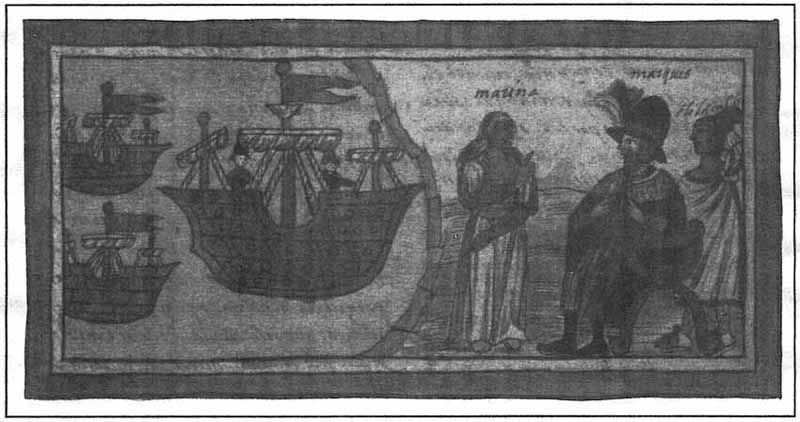
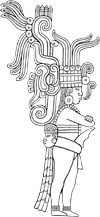
|
Death Gods, Smiling Faces and Colossal Heads: Archaeology of the Mexican Gulf Lowlands by Richard Diehl |
|
| |
The Postclassic Period (A.D. 900-1521) The archaeology of the Postclassic period is even more poorly known than that of the Classic. Nevertheless, several general trends can be discerned: political fragmentation followed by the initial steps of reintegration, small-scale population movements, and renewed intrusions by central Mexican imperialists. The period opened with the aftermath of El Tajin's decline in the north and the abandonment of most Classic sites in the central and southern portions of the region. Many new centers sprang up to replace the deserted Classic communities, but none were able to establish hegemony over large areas until Cempoala, in the Misantla region north of modern Veracruz City, emerged as the Totonac capital a century before the Spanish Conquest. Many of these centers were placed on hilltops or other easily defended settings, suggesting that warfare and strife were a fact of daily life. The contacts with the Maya region that were so prominent during the Late Classic withered at the end of the period and ultimately were replaced with renewed ties to central Mexico. Groups in the Huasteca maintained fairly close ties with the Toltecs of Tula and their Aztec successors. The relationships with the Toltecs appear to have been social and commercial in nature, but the Aztecs actually conquered several Huastec-speaking areas and extracted regular tribute payments from them. Farther south, Early Postclassic ceramics in central Veracruz show strong highland Mixteca-Puebla stylistic influence, and central Mexican architectural designs and concepts appear in Cempoala, Quiahuiztlan, and other Totonac centers in Late Postclassic times. As had happened farther north, the Aztecs ultimately incorporated the Totonac realm into their empire at the end of the fifteenth century. The unsettled conditions during the early centuries of the Postclassic encouraged small-scale population movements within the region, which culminated in the basic tripartite geolinguistic distribution that existed when the Spaniards arrived. The names of the regions – Huasteca, Totonacapan, and Olmecapan – are corruptions of the Nahuatl names Bernardino de Sahagun recorded in his encyclopaedic work on Aztec life and culture. In addition, Sahagun's work contains short descriptions of the Gulf Coast peoples prepared by his Aztec informants. Although these descriptions are as biased and ethnocentric as the Spanish accounts of the Aztecs, they do contain invaluable information of the sort not normally available to archaeologists. The Huasteca Huasteca language, related to the Maya language family of southern Mesoamerica, predominated in northern Veracruz and adjacent portions of Tamaulipas, San Luis Potosi, Queretaro, and Hidalgo in the sixteenth century. Small enclaves of speakers of Nahuatl, Nahuat, and Otomi lived interspersed with the Huastec majority. Huastec was long established in the region, but Nahuat was a relatively recent arrival and Nahuatl was probably introduced during the Aztec conquest in the fifteenth century. According to the Aztecs, the hot Huastec lands were rich in food and other desirable goods. Cotton textiles, especially mantles, were the primary tribute the Aztecs exacted from their Huastec subjects. According to Sahagun, Huastec men dyed and parted their hair, letting it hang over the earlobe; filed and stained their teeth; and inserted feathers, palm leaves, or gold plugs into openings in their nasal septa. They dressed in gorgeous feathered capes, leather arm and leg bands, and greenstone bracelets, and they wore circular devices of brilliant feathers and woven palm leaves on their backs. Huastec women wore skirts and braided their hair with multicolored strips of cloth wound with feathers. Huastec warriors employed the bow and arrow with effectiveness, and their valor earned the respect of the Aztecs. The Huastecs suffered two very serious defects in the eyes of the rather puritanical Aztecs. The men generally did not wear loincloths, preferring to leave their genitals exposed, a practice that scandalized Aztecs and Spaniards alike. Furthermore, they loved pulque, an intoxicating drink made by fermenting sap from the maguey or agave cactus, in what the Aztecs considered excessive quantities. Although most imbibing probably occurred during rituals that the participants viewed as serious worship, the Aztecs considered their Huastec neighbors to be drunken carousers. Aztec legend tells of a Huastec lord at Tula who, not satisfied with just four cups of pulque, had a fifth, after which he removed his loincloth in public. Upon sobering up, he was so ashamed that he fled to his homeland, where he instilled his wicked ways in his descendants. This perhaps apocryphal event is reflected in the Aztec saying applied to drunkards: "He is the image of a Huaxteca. He drank not only the four wine jars, he finished the fifth" (Sahagun Book 10:194). Little is known about Late Postclassic archaeological remains in the Huasteca beyond the basic ceramic typology, the remarkably well-preserved temple at Castillo de Teayo, and a large corpus of stone sculpture (Figs. 4.11, 4.12). The ceramics include very distinctive black-on-white vessels, which were traded into the highlands of central Mexico. The temple at Castillo de Teayo, virtually the only example of an intact temple sanctuary in Mesoamerica outside the Maya region, has pronounced affinities with Aztec architecture from the Basin of Mexico.
Scores of stone monuments attest to the popularity of sculpture as a form of artistic expression in the Huasteca during the Postclassic, but unfortunately the basic chronology of their development remains a mystery. They frequently depict deities or at least people wearing godly insignia, especially related to the Wind God Ehecatl. The Totonacapan The Totonacapan covered a broad band of territory centered on the Sierra de Chiconquiaco in central Veracruz. When Hernando Cortés (or Cortéz) arrived in their territory in 1519, the Totonacs of Cempoala dominated the region but were in turn under Aztec subjugation. They quickly turned on their highland overlords by becoming Cortés's first Indian allies, without whom he never could have conquered the Aztecs. Although scholars tend to credit the Totonacs with more accomplishments than are really their due, including the construction of El Tajin, they certainly played an important role in lowland history. Tepehua, a language closely related to Totonac, is still spoken in isolated portions of the mountains and may have been more widespread in the past. Sahagun's informants considered the Totonacs to be a cut above their Huasteca neighbors: "To these corresponded a humane, civilized life." The Aztecs found them attractive physically, "and the men and women were beautiful, fair, tall, slender, firm." Their clothing, hair, and accoutrements are described as elegant, and the Totonacs were famed for their woven and embroidered cotton garments. They were skilled in song and dance and famous for their meat tamales, tortillas, and chile peppers. On the other hand, the Aztecs had scant respect for the Totonacs as warriors. Totonacapan's wealth attracted the Aztecs early in their imperial history. The region supplied crucial foodstuffs to central Mexico during the devastating famines of the early 14505. It is said that during these hard times families in the Basin of Mexico sold their children into slavery in exchange for maize from the Totonacapan, and some highland groups may have migrated to this fertile paradise where hunger was unknown. Shortly thereafter the Aztecs subjugated southern Totonacapan during the reign of Moctezuma the Elder (1440-69); the northern sector escaped the Aztec yoke until Moctezuma the Younger conquered it at the beginning of the sixteenth century. Aztec tribute demands included vast quantities of cotton bales and cloth; warriors costumes with shields; cacao; liquid amber; feathers; and ornaments made of gold, crystal, and amber. Maize and other foodstuffs, although not mentioned in the tribute lists, probably entered the highlands through the market system rather than the state-directed tribute system. Archaeologists have not directed much serious attention to Late Postclassic sites in the Totonacapan. At Cempoala, the historic Totanac capital where Cortes formed his first alliance against the Aztecs, some of the temples have been cleared and restored. The hilltop site of Quiahuiztlan, another historic community which overlooks Cortes's landfall and the site of La Villa Rica de la Veracruz, the first Spanish settlement in Mesoamerica, is famous for the multitude of tombs in the form of miniature temples that lie scattered about its plazas (Fig. 4.13).
Olmecapan The ethnolinguistic situation east of the Papaloapan River is not well documented. The Aztecs called the inhabitants the Olmeca, the "Rubber People" and the Uixtotin, the "Saltwater People," but these are geographical referents rather than languages. The languages recorded for the area in the sixteenth century include Popoluca and Nahuat. Popoluca appears to be an ancient language in the area related in some way to the Mixe and Zoque languages spoken in the Isthmus of Tehuantepec. The Nahuat was similar, if not identical, to that spoken in northern Veracruz. Both languages were spoken from the Tuxtla Mountains to the western Tabascan floodplain. The evidence suggests that speakers of both languages lived intermingled with each other rather than in discrete isolated blocks. Finally, Mixtec speakers may have occupied portions of the Papaloapan basin, but the evidence is ambiguous. The Aztecs controlled the Papaloapan River basin from Tochtepec, a garrison town located in modern Oaxaca near the Veracruz border, but it is not clear whether they also controlled the Tuxtla Mountains. Although Aztec merchants traveled into the Coatzacoalcos basin and western Tabasco, these regions were independent politically and did not pay tribute to Aztec overlords. However, some evidence suggests that the Aztecs had imperial designs on the region, designs aborted by the arrival of the Spaniards. The Aztecs certainly were impressed with the wealth of the area. They also believed it to be Tlapallan, homeland of Quetzalcoatl, the deified culture-hero who brought civilized life to their Toltec ancestors. According to Aztec legend, Quetzalcoatl returned to Tlapallan after his enemies defeated and shamed him at Tula. He then sailed off to the east on a raft of serpents, promising to return one day. When the Spaniards came out of the east in strange boats, Moctezuma and his advisors quite naturally mistook the bearded strangers for Quetzalcoatl and his followers. This mistake proved costly, creating divisiveness and causing procrastination when only swift and unified action could have saved the day for the Indians. The Olmecapan was involved in a further irony of the Spanish Conquest. It was here that Cortes received a group of women as the gift of a local chief. They included Dona Marina, sometimes called La Malinche, the daughter of a noble family who became his interpreter, confidante, and mistress (Fig. 4.14). Time and again her intelligence and advice helped him avoid ambushes and thread his way through interminable mazes of political intrigue. So effective was she that today in Mexico her name is used as a synonym for traitor. Thus, the Land of Wealth fronting on the Gulf of Mexico, so important to precolumbian Mesoamerica, provided both geographical springboard for the European conquest and the woman who perhaps more than anyone else made it possible.
|
|
|
Text links to all pages at this site are available at the FAMSI INDEX |
||
